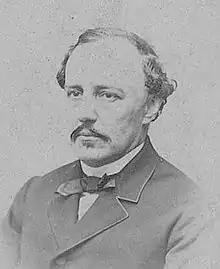Alexander Hamilton Jr. | |
|---|---|
 Hamilton in December 1863 | |
| Secretary of the United States Legation at Madrid | |
| In office 1848–1850 | |
| Personal details | |
| Born | January 26, 1816 New York City, U.S. |
| Died | December 30, 1889 (aged 73) New York City, U.S. |
| Spouse | |
| Children | 1 son |
| Parents |
|
| Relatives | See Hamilton family |
| Alma mater | United States Military Academy |
| Occupation | Lawyer |
| Signature | |
Alexander Hamilton Jr. (January 26, 1816 – December 30, 1889), was the son of James Alexander Hamilton, and the grandson of Alexander Hamilton, one of the Founding Fathers of the United States.
Early life
Hamilton was born on January 26, 1816, in New York City. He was the third of five children, and the only son, born to James Alexander Hamilton (1788–1878) and Mary Morris, the daughter of Robert Morris and Frances Ludlum and the sister of Lewis Gouverneur Morris (1808–1900).[1]
His paternal grandparents were Alexander Hamilton (1755–1804), the first Secretary of the Treasury, and Eliza Schuyler (1757–1854). His grandmother was the second daughter of Philip Schuyler, a Revolutionary War general, and Catherine Van Rensselaer, of the Van Rensselaers of the Manor of Rensselaerswyck, one of the richest and most politically influential families in the state of New York.[2]
Hamilton attended the United States Military Academy at West Point from July 1832 to June 1835.[3]
Career
He became a lawyer in New York City, and was a founding partner in the law firm of Hamilton and Lyon.[4] From June 1842 to April 1844, he was the Secretary of the United States Legation at Madrid, serving under Washington Irving.[4] He retired from the practice of law in 1870.[4]
U.S. Civil War
In April 1861, during the American Civil War, Hamilton was appointed a volunteer aide-de-camp to General John E. Wool, who commanded the U.S. Army's Department of the East in New York.[5]: 219 [3] On August 28, 1861, he was given an official position as Wool's additional aide-de-camp, and served in that capacity until he resigned on December 11, 1861.[3] In July 1863, during the New York City draft riots, he again assisted Wool, who reported to Governor Seymour that his "former aid[e], Colonel Alexander Hamilton Jr. ... volunteered especially for this occasion, and [was] constantly in attendance day and night."[6]
Hamilton wrote to President Lincoln in a letter dated May 26, 1862, calling Secretary of War Edwin Stanton's division of General George McClellan's Army of the Potomac into four separate departments "the grossest mismanagement."[5]: 629, 635
Personal life
In 1845, after his return from Spain, he married Angelica Livingston (1820–1896), the daughter of Maturin Livingston (1769–1847). Angelica's mother was Margaret (née Lewis) Livingston (1780–1860), the only daughter and sole heiress of Gov. Morgan Lewis (1754–1844).[7] They had one son, Alexander, born in 1848, who died at the age of 11 months.[7]
Hamilton was a founding member, and the first president, of New York's Knickerbocker Club when it was organized in 1871.[4] He was also a founder of the Union League Club.[4]
References
- ↑ Fell, A. London (1983). Origins of Legislative Sovereignty and the Legislative State, Volume 1. Greenwood Publishing Co. p. 395. ISBN 9780275939762.
- ↑ Reynolds, Cuyler (1914). Genealogical and Family History of Southern New York and the Hudson River Valley: A Record of the Achievements of Her People in the Making of a Commonwealth and the Building of a Nation. Lewis Historical Publishing Company. p. 1343.
Maturin Livingston married Margaret Lewis.
- 1 2 3 Heitman, Francis B. (1890). Historical Register of the United States Army, From Its Organization: September 29, 1789, to September 29, 1889. Washington, D.C.: The National Tribune. p. 315.
- 1 2 3 4 5 "Hamilton, Alexander". Appletons' Annual Cyclopedia and Register of Important Events of the Year 1889. Vol. XXIX. D. Appleton and Company. 1890. p. 633.
- 1 2 Beatie, Russel H. (2007). Army of the Potomac. Vol. McClellan's First Campaign, March–May 1862, Volume 3. Savas Beatie. pp. 219, 629, 635. ISBN 978-1-61121-021-7 – via Google Books.
- ↑ "Report of General Wool to Governor Seymour" (July 20, 1863), in Seymour, Horatio (1868). Cook, Thomas M.; Knox, Thomas W. (eds.). Public Record: Including Speeches, Messages, Proclamations, Official Correspondence, and Other Public Utterances. New York: I. W. England. p. 135.
- 1 2 Reynolds, Cuyler (1914). Genealogical and Family History of Southern New York and the Hudson River Valley: A Record of the Achievements of Her People in the Making of a Commonwealth and the Building of a Nation. Lewis Historical Publishing Company. p. 1383.
Livingston.